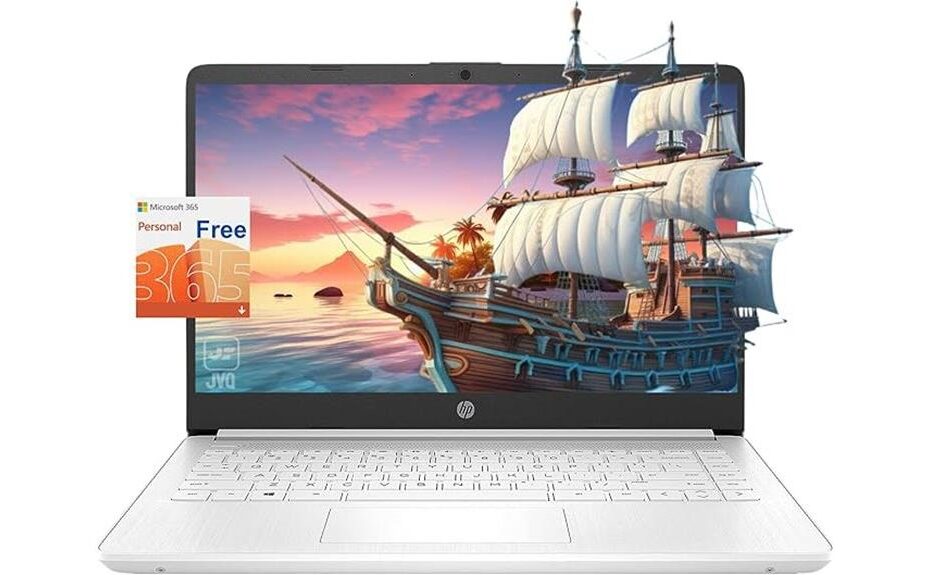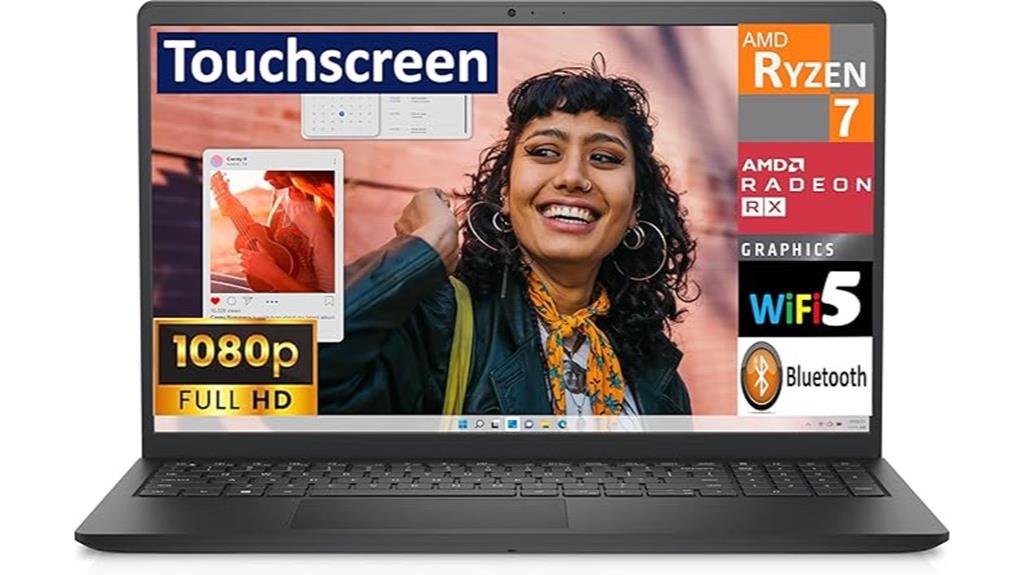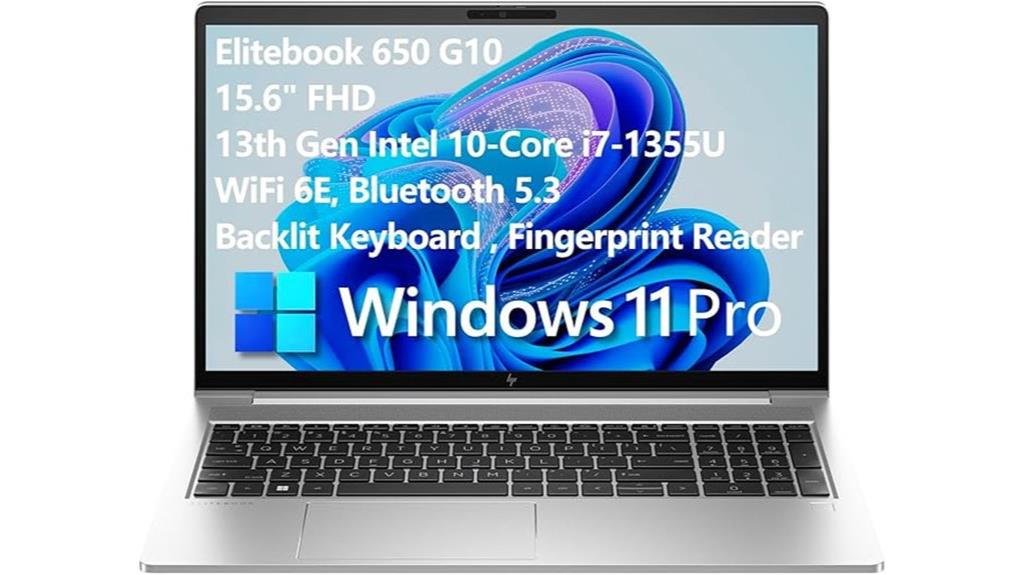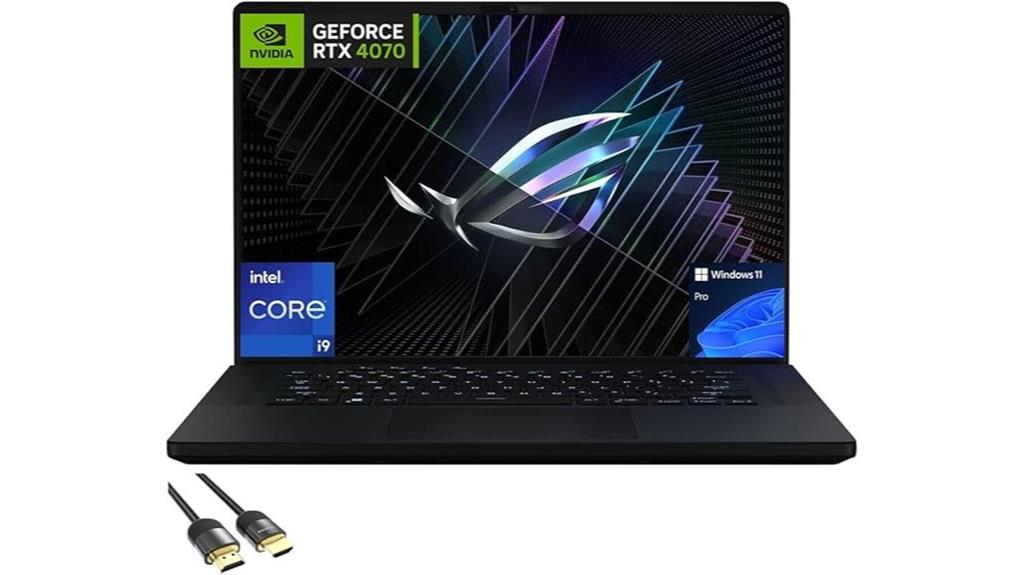







I've spent time with the HP Stream Laptop, and while its lightweight design and impressive battery life make it a tempting choice for casual users, there are some trade-offs worth noting. The 16GB RAM and included Office 365 subscription add value, but the 64GB eMMC storage and Intel Celeron processor raise questions about reliability and performance. Is this laptop a budget-friendly gem or a device that struggles under pressure? Let's break down the pros, cons, and whether it's the right fit for your needs—there's more to uncover than meets the eye.
Key Takeaways
- Lightweight and portable design, ideal for students and professionals prioritizing mobility over high-end performance.
- Limited 64GB eMMC storage and frequent crashes hinder long-term reliability and usability.
- Includes 1-year Office 365 subscription and 1TB OneDrive storage, enhancing productivity for basic tasks.
- 14-inch HD anti-glare display with modest brightness and color accuracy, suitable for casual use but not creative work.
- Mixed customer satisfaction due to budget-friendly price, slow performance, and inability to handle demanding applications.
##
While the HP Stream Laptop's 14-inch HD display and lightweight design make it visually appealing and portable, its performance is limited by the Intel Celeron N4120 processor and 16GB RAM. The 64GB eMMC storage is insufficient for extensive software, and the internal drive is prone to crashes, necessitating frequent recovery attempts. I recommend implementing robust data backup strategies, such as using external drives or cloud storage, to mitigate data loss risks. Creating a recovery drive immediately after setup is a critical drive recovery tip, as the laptop's lifespan can be short, with some units failing within months. For basic tasks, it's functional, but its limitations demand proactive measures to safeguard your data and guarantee usability. The laptop's up to 11 hours of battery life makes it a reliable choice for users who need extended usage without frequent charging.
Features and Benefits
The HP Stream Laptop offers 6GB of RAM, enabling smooth multitasking for basic applications and browser tabs. Its 14-inch HD anti-glare display provides decent clarity for everyday use, though brightness is limited to 220 nits. The lightweight, portable design enhances mobility, and the inclusion of a 1-year Office 365 subscription adds value for productivity tasks. The Intel Celeron N4120 processor ensures efficient performance for everyday computing needs.
6GB RAM for Smooth Multitasking
With 16GB of high-bandwidth RAM, the HP Stream Laptop guarantees smooth multitasking, allowing you to run multiple applications and browser tabs simultaneously without significant lag. The RAM optimization secures efficient resource allocation, enhancing multitasking efficiency even during demanding workloads. This setup is ideal for users juggling productivity tools, streaming, and web browsing. The high-bandwidth design minimizes bottlenecks, guaranteeing responsive performance across tasks. While the laptop excels in basic multitasking, its capabilities are best suited for lightweight applications rather than memory-intensive software. The 16GB configuration provides a buffer for future updates, though the limited internal storage may constrain extensive software installations. Overall, the RAM configuration delivers reliable performance for everyday use, making it a practical choice for casual users prioritizing multitasking efficiency.
4-Inch HD Anti-Glare Display
Featuring a 14-inch diagonal HD (1366 x 768) micro-edge, anti-glare display, the HP Stream Laptop offers a practical visual experience for everyday use. The screen resolution is adequate for basic tasks like browsing, streaming, and document editing, though it falls short for detailed creative work. The anti-glare coating reduces reflections, making it easier to use in well-lit environments. However, the display brightness, rated at 220 nits, is modest and may struggle in very bright settings. While the 45% NTSC color gamut limits vibrancy, it's sufficient for casual use. For its price point, the display balances functionality and affordability, catering to users who prioritize portability and simplicity over high-end visual performance. It's a solid choice for students or professionals needing a no-frills screen.
Lightweight, Portable Design for Mobility
Although portability is a key selling point for many laptops, the HP Stream Laptop stands out with its lightweight design, weighing just under 3 pounds. This makes it ideal for travel convenience, as it's easy to slip into a bag without adding significant bulk. The compact 14-inch form factor enhances easy handling, whether I'm moving between meetings or working on the go. The slim profile and micro-edge display contribute to its portability, ensuring it doesn't feel cumbersome during extended use. While the lightweight build is a clear advantage, it's worth noting that the materials feel sturdy enough for daily use. For users prioritizing mobility, the HP Stream delivers a practical solution, balancing portability with functionality for basic tasks.
-Year Office 365 Included
The HP Stream Laptop comes with a one-year subscription to Office 365, offering immediate access to essential productivity tools like Word, Excel, PowerPoint, and Outlook. This inclusion enhances office productivity right out of the box, eliminating the need for separate software purchases. Office 365 guarantees software compatibility across devices, allowing seamless document editing and collaboration. The subscription also provides 1TB of OneDrive cloud storage, which is particularly useful given the laptop's limited internal storage. While the subscription is a significant value-add, users should note it's only for one year, after which renewal is required. For students or professionals relying on Microsoft's ecosystem, this feature makes the HP Stream a practical choice for basic office tasks and cloud-based workflows.
Product Quality
While the HP Stream Laptop boasts a sleek design and lightweight build, its product quality raises significant concerns. Drive reliability is a major issue, with the internal 64GB eMMC storage prone to frequent crashes and failures. Many users report data loss and boot issues, often rendering the device unusable. Build durability also falls short, as some units fail within months of use. The laptop's lightweight construction, while convenient, feels flimsy and less robust compared to competitors. These shortcomings make it unreliable for long-term use, especially for those relying on it for essential tasks. While it's visually appealing, the HP Stream's quality compromises its practicality, leaving users questioning its longevity and dependability. Additionally, the Intel Celeron 1.1 GHz processor, while fast for basic tasks, struggles with more demanding applications, further limiting its versatility.
What It's Used For
The HP Stream Laptop is designed for basic computing tasks like web browsing, email, and light productivity, thanks to its 16GB RAM and Intel Celeron processor. Its lightweight build makes it ideal for portability, but the limited 64GB internal storage restricts it to minimal software and OS use. The 14-inch HD display with Micro-edge BrightView technology enhances the viewing experience, making it suitable for casual users who prioritize mobility over storage or performance-intensive applications.
Basic Computing Tasks
Designed primarily for basic computing tasks, the HP Stream Laptop handles everyday activities like web browsing, email management, and document editing with ease. Its Intel Celeron N4120 processor and 16GB RAM deliver adequate basic performance for light multitasking, such as running multiple browser tabs or lightweight applications. Task efficiency is solid for casual use, though the 64GB eMMC storage limits software installations, making it best suited for cloud-based workflows. The 14-inch HD display provides clear visuals for productivity, while the anti-glare coating reduces eye strain during extended use. However, I'd avoid pushing it beyond basic tasks, as advanced software or heavy workloads can strain its capabilities. For students or professionals needing a no-frills device, it's a functional choice for routine computing.
Lightweight Portability
Weighing just under 3 pounds, the HP Stream Laptop excels in portability, making it an ideal companion for users constantly on the move. Its lightweight design guarantees travel convenience, whether I'm commuting, working remotely, or attending meetings. The compact form factor fits easily into backpacks or small bags, reducing strain during extended use. While the battery life isn't exceptional, it's sufficient for basic tasks on the go, lasting around 8-10 hours with moderate usage. This makes it suitable for short trips or daily commutes without needing frequent recharges. The slim profile and durable build enhance its practicality for mobile professionals or students who prioritize ease of transport. However, its lightweight nature doesn't compromise essential functionality, balancing portability with usability for everyday needs.
Limited Storage Usage
Although the HP Stream Laptop's 64GB eMMC storage is limited, it's primarily designed to handle the operating system and essential software, leaving little room for additional applications or files. This setup demands careful data management, as the internal drive fills quickly with system updates and basic programs. For storage optimization, I rely heavily on external solutions like the included 256GB USB drive or cloud services. However, installing software directly on external storage isn't always supported, which complicates usage. The limited internal space also means frequent file transfers and deletions to free up room. While the eMMC guarantees fast boot times, its capacity constraints make it unsuitable for users with extensive storage needs, emphasizing the importance of external backups and efficient storage practices.
Product Specifications
The HP Stream Laptop features a 14-inch HD micro-edge display with a resolution of 1366 x 768, offering anti-glare properties and a brightness of 220 nits, though its color coverage is limited to 45% NTSC. Its Intel Celeron N4120 processor delivers modest processor performance, with a burst frequency of up to 2.6 GHz, 4 cores, and 4 threads, suitable for basic tasks. Connectivity options include a SuperSpeed USB Type-C, two USB Type-A ports, HDMI 1.4, and an RJ-45 Ethernet port, ensuring versatility for peripherals and external displays. The laptop also supports Wi-Fi and Bluetooth for wireless connections. The 16GB DDR4 SDRAM ensures smooth multitasking capabilities, making it ideal for students and professionals.
| Feature | Specification | Notes |
|---|---|---|
| Display | 14-inch HD (1366 x 768) | Anti-glare, 220 nits |
| Processor | Intel Celeron N4120 | Up to 2.6 GHz, 4 cores |
| Connectivity | USB-C, USB-A, HDMI, RJ-45 | Wi-Fi, Bluetooth included |
Who Needs This
If you're looking for an affordable, lightweight laptop for basic tasks like web browsing, email, and light document editing, the HP Stream Laptop might fit your needs. It's ideal for students studying or anyone who prioritizes portability and simplicity over high performance. The 16GB RAM guarantees smooth casual browsing and multitasking, while the compact design makes it easy to carry around. However, the limited 64GB internal storage restricts its use to lightweight applications, so it's not suitable for memory-intensive tasks or advanced software. If your primary needs include streaming, online research, or basic productivity tools, this laptop could work well. Just keep in mind its limitations for more demanding workflows or extensive file storage. The Intel Celeron processor ensures efficient performance for everyday tasks, making it a reliable choice for casual users.
Pros
For users seeking an affordable and portable device, the HP Stream Laptop offers several advantages. Its affordable price makes it accessible for budget-conscious buyers, while the easy setup guarantees you can start using it quickly. Here are its standout features:
- Lightweight design: At just over 3 pounds, it's highly portable for students or professionals on the go.
- Included software: Comes with Windows 11 Home and a 1-year Office 365 subscription, adding value.
- Decent performance: The 16GB RAM handles multitasking smoothly for basic tasks like browsing and document editing.
- HD display: The 14-inch anti-glare screen provides clear visuals for everyday use.
- Versatile ports: Includes USB Type-C, HDMI, and an RJ-45 port for connectivity flexibility.
- User-friendly interface: The Chrome OS ensures seamless navigation and multitasking, similar to the HP Chromebook 14 G5.
These features make it a practical choice for casual users prioritizing affordability and convenience.
Cons
While the HP Stream Laptop has its merits, it's not without significant drawbacks. The device struggles with reliability, particularly concerning its internal storage and performance. Here are the key cons:
- Drive failures: The 64GB eMMC storage is prone to sudden failures, often rendering the laptop unbootable.
- Frequent crashes: Users report recurring system crashes, requiring frequent recovery attempts.
- Limited storage: The internal drive is insufficient for anything beyond basic tasks, forcing reliance on external storage.
- Short lifespan: Some units fail within months, raising concerns about durability.
- Recovery challenges: Even recovery attempts often fail, leaving the device unusable.
- Performance limitations: Similar to the Acer Aspire 1, the HP Stream struggles with demanding tasks and multitasking, making it unsuitable for advanced software usage.
These issues make the HP Stream Laptop a risky choice for anyone needing dependable performance or long-term use.
What Customers Are Saying
Although the HP Stream Laptop has garnered praise for its sleek design and portability, customer feedback highlights significant concerns about its performance and reliability. Many users report frequent crashes and drive failures, often leading to data loss and unsuccessful recovery attempts. Customer complaints frequently mention the short product lifespan, with some units failing within months of purchase. The internal 64GB eMMC storage is particularly problematic, as it's prone to failure and insufficient for most users' needs. While the laptop is praised for basic tasks, its limitations in handling advanced usage and the recurring issues with recovery have left many dissatisfied. These recurring problems underscore the importance of backing up data and managing expectations regarding its durability and performance. In contrast, the HP 2023 Envy Laptop offers up to 4TB PCIe NVMe M.2 SSD, providing ample storage and faster performance for demanding tasks.
Overall Value
The HP Stream Laptop's overall value is heavily influenced by its balance of affordability and functionality, but its limitations and reliability issues raise significant concerns. In a price comparison with similar budget laptops, it stands out for its lightweight design, 16GB RAM, and included Office 365 subscription. However, a budget analysis reveals trade-offs: the 64GB eMMC storage is insufficient for most users, and the external 256GB USB storage doesn't fully compensate. Frequent drive failures and short product lifespan further diminish its value. While it's suitable for basic tasks, its reliability issues make it a risky investment for long-term use. For those prioritizing cost over durability, it's a viable option, but I'd caution against relying on it for critical work. For users seeking a more robust solution, the HP 17.3 inch HD Touchscreen Laptop offers superior performance and storage capacity, making it a better choice for demanding tasks.
Tips and Tricks For Best Results
To maximize the HP Stream Laptop's performance, I recommend prioritizing external storage solutions and optimizing system settings. Given the limited 64GB eMMC storage, rely on external drives for apps and files. Implement robust data backup strategies, such as cloud storage or external drives, to safeguard against internal drive failures. Create a recovery drive immediately after setup to guarantee quick restoration if the system crashes. Regularly clear cache and disable unnecessary startup programs to free up resources. Use lightweight software alternatives to reduce strain on the system. Avoid overloading the internal drive, as it's prone to failure. These steps will help maintain functionality and extend the laptop's usability for basic tasks.
Conclusion
While the HP Stream Laptop offers a lightweight design and affordability, its limitations outweigh its benefits for most users. The laptop durability is a significant concern, with frequent reports of internal drive failures and short lifespans, often within months of use. Customer satisfaction is mixed; while some appreciate its portability and ease of setup, many are frustrated by its limited storage, slow performance, and inability to handle advanced tasks. The 64GB eMMC storage is insufficient for most software needs, and the external USB storage doesn't fully compensate. For basic tasks like browsing and emails, it's passable, but I can't recommend it for demanding workloads or long-term reliability. Ultimately, its flaws make it a risky investment despite its budget-friendly price.




